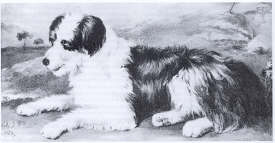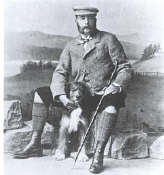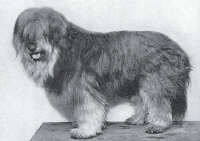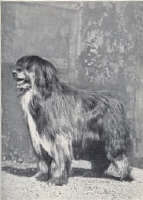At bottom of this article - read the Bearded Collie text of the Dogs of Scotland (1891)
At bottom of this article - read the Bearded Collie text of the Dogs of Scotland (1891)
Early History of the Bearded Collie
Glenn D. Short (originally written in 1996)
In the past the Bearded Collie was sometimes known as the Mountain Scotch Collie, Old Welsh Grey Sheepdog, Highland Collie, Loch Collie, or the Hairy Moued Collie. Today they are often referred to as "Beardie."
The name "Collie" itself has always been pondered over as to it's origin. Most who are not familiar with the breed wonder if this implies that the Bearded Collie is somehow related to the Collie dog known as the "Rough Collie" as in the famous Lassie series. It is generally recognized that the term "Collie" as part of the breed name does not imply this relationship, rather it is some word that describes the function of the dog (as does "sheep dog"). Some feel that the term "Collie" or Colly is derived from the pronunciation of the word "coaley" - referring to the black faced sheep found in Scotland. Others feel that "Collie" refers to the Gaelic word meaning "useful."
Bearded Collies are thought to be one of Britain's oldest breeds, existing there since the 1600-1700s (or possibly even before). The fact that they are a herding breed, and thus we valued primarily for their use as working dogs, makes their origin and development as a breed difficult to trace. Breeding records were not formal as they were for dogs owned by the upper class. They were bred for their abilities to work rather than their looks (for herding not for show). It was not until the early 1900s that any attempt was made at standardizing the breed, and that was more of a working standard (Edinburgh, Scotland -1912). The first written description, so far as we have found, was in "The Dogs of of Scotland" D.J. Thompson Gray in the 1880s as outlined later in this article and in the attachment found below. Prior to that it is likely that the working dogs or Shepherd's Dogs were bred for function and sometimes without any planning.
So where did this breed come from? There are many theories, and of course none can be proved without a doubt due to the lack of records. It is here that we will begin yet another study of the history of the Bearded Collie. Hopefully ours will be a little more fun.
Common Theory
The most popular theory is that the Bearded Collie originated from some sort of cross breeding with the Polish Lowland Sheepdog (also known as the PON). Scotland and Poland had quite a bit of commerce in the late 15th and 16th century and their are reports of records (old ship manifests, showing the PON being brought to Britain at that time. In one theory, Kazimierz Grabski, a Polish merchant, traded grain for sheep in Scotland in 1514, and brought Polish Lowland Sheepdogs to move the sheep. Presumably the PON became mixed with other local herding dogs and the Bearded Collie emerged over the years. Another theory relates the introduction of the Komdor to Scotland with the existence of the Bearded Collie. The Komodor, thought to be of Asian origin, is thought to have been brought to Hungary my the Magyars. However, some believe long coated sheep dogs were in Britain as early as 2000 BC (I have found no information as to what led to that thought). It has also been pointed out by many that there is only evidence that 3 (or 6?) of the PON were brought into Britain, and they most certainly were intermixed with other dogs.
Interestingly, a study of the history of the sheepdog done by Iris Combe (Herding Dogs, their Origins and Development in Britain, 1987) favored the idea that the ancestry of hill dogs in the north of Britain can be traced back to the Roman occupation. Presumably the Romans, who are known to have imported sheep into Britain, also imported the shepherds and their dogs. The basis of this theory is more likely for other dog breeds where evidence has been found, such as drover types found in Ireland, as the sheep imported were of the domesticated types from Iberia and North Africa. But the uncanny likeness of the Bearded Collie to the Egyptian sheepdog , also called Armant, lends some credibility to this theory.
Still, others have theorized that the Anglos brought the long coated shaggy herding dogs from the European continent where there are many similar looking breeds. Some say that they could have been related to or mixed with the Old English Sheepdog (OES). However others feel that the Beardie was the predecessor and somehow became part of the background of other herding breeds of the British Isles. Most agree that at some point the OES was intermixed into the breed in a small way when the breed was transformed into a fixed recognizable breed. Most agree the Bearded Collie came before the Old English Sheepdog and therefore would not have developed out of that breed.
The fact is that many herding breeds developed that have similar characteristics and "look." The Sumer people, about 5000 BC, have been said to have kept the ancient Puli, Komodor, and Kuvasz. Other breeds with resemblance are the Polish Lowland Sheepdog (PON), Bergamascho, Portuguese Sheepdog (presumably the long haired), and the Gos d' Atura (Catlan). But in fact little is known of the ancient ancestry as little records were kept. Herding dogs were bred to do a job, and it is likely that they intermixed. Even so, old drawings and painting have shown a remarkable resemblance and thus evidence, that the Bearded Collie had been present in a more or less similar form for hundreds of years in the British isles, mainly to the North of England and in Scotland.
Whether the original ancestor of the Bearded Collie was brought to Britain by the Romans, Anglos or Polish traders, it is likely that there was a great deal of intermixing with other herding dogs. One report indicated that there were over 1000 recognizably different types of herding dogs in the northern of Britain and Scotland by the late 1800s, and some were referenced as "curs" (mixes). So, in effect, any or all the theories may be correct.
The working dog has many functions. For example, it is thought that one strain of the Bearded Collie was developed to work in the hills (or Highlands), locating stray sheep on mountainsides as a sheepdog. They would hunt out the sheep, barking when necessary to cause the sheep to gather. Others would be used as drovers, taking sheep and other livestock to the market. Yet another strain may have been used more as an all purpose dog - possibly crossing with breeds such as the border collie. It is almost definite that Bearded Collies were valuable as drovers or cattle dogs. Today we commonly hear about the two types of Bearded Collie. The Border strain, being the coarser coated slate-colored (black or gray with white markings); and the smaller Highland strain with the shorter wavy type coat being brown or fawn with white markings..
|
1803 - "The Shepherd's Dog" by P. Reinagle It was described as an Old English Sheepdog |
 |
| 1846 - A etching (from drawing) of a Bearded Collie for Jesse's Anecdotes. Original attributed to an engraving by W. P. Smith (1832-1851) entitled "Scotch Colly" circa 1844. |  |
| 1854 - "The Shepherd's Dog" by W. Barrard. |  |
1878 in Dogs of the British Islands by J.H.Walsh ("Stonehenge") - "In Scotland and the north of England, as well as in Wales, a great variety of breeds is used for tending sheep, depending greatly on the locality in which they are employed, and on the kind of sheep adopted in it ........... "
1891 - Dogs of Scotland by D.J. Thompson Gray describes the Bearded Collie for the first time - following some articles in the 1880s.
1897 - The Bearded Collie is requested to be shown in the show ring for the first time on record at the Scottish Kennel Club. However history would delay the actual showing as the owner Parmure Gordon declined to show the dog himself.
| Mr Panmure Gordon - President of the Scottish Kennel Club about 1900 with a Bearded Collie |  |
|
By 1901 there were still Bearded Collie looking dogs that may have been mixed with Border Collies, used in herding. Or possibly these were the "border strain" rather than the highland. This led to the idea that "Owd Bob" or Bob Son of Battle may have been a Bearded Collie. Photo at Right Bob, Son of Battle Doubleday, Page & Co 1903 1901-1903 W.D.Drewry published British Dogs (photo at right). First in a 3 book collection, later in a single 662 page volume (.London,L.Upcott Gill,1903, 3rd edition) 1907 By the time "Show Dogs" by Theo Marples (Editor of "Our Dogs") was published, the Scotch Bearded Collie was depicted as follows: "The Bearded Collie is a very old Scottish variety, and indigenous to Scotland, but undoubtedly a member of the same family as the Old English Sheepdog, both of which no doubt had one common origin." The same photo was used. In essence this reference to the Bearded Collie as a show dog was prior to formal standardization to the breed for showing in 1912. |
|
1912 - The Bearded Collie Society in Edinburgh Scotland was founded by J. Russle Greig - however is was short lived due to W.W.I
In the 1930's Mrs. Cameron Miller made an attempt to increase the popularity of the Bearded Collie. Most photos during the decade were from her breeding. Perhaps without her interest in the breed the Beardie might have disappeared.
|
1931 About Our Dogs - Croxton Smith described the bearded collie as being similar looking to the Old English Sheepdog. "But the Scottish dog is smaller, not so strong in the muzzle, has a small beard under his chin and his tail has not been docked". "The colour varies, but a dark hazel is preferred" And also "the hero of Alfred Ollivant's 'Owd Bob' " - which may have been the first to acknowledge this in writing. He noted that they were "extremely scarce" in 1930, with no official breed standard. |
 "Balmacneil Jock" owned by Mrs. Cameron Miller |
| 1934 Hutchinson's Dog Encyclopedia depicted the breed as it was evolving into what we see today. Although these photos show more black on the face than commonly seen today. Even so it noted that "very little has been written about this breed and consequently it suffered in popularity. The photo, which originally was credited to the Scotsman and Evening Dispatch, was also used in the soft cover How to Choose a Dog by Vero Shaw as revised by Arthur Marples in 1934 (4th ed). |
|
|
|
|
| "Yet the Beardie has a marvelous temperament, is gentle and affectionate and easily controlled, even very young puppies readily obey commands." |
 "Balmacneil Scott" owned by Mrs. Cameron Miller |
During WWII the number of Bearded Collies declined. Some feel this was due to Shepherds not being able to feed them. However shepherds were never a wealthy lot. It may be more likely a result of Mrs. Cameron Miller passing away and the probable loss of interest in dog shows in general. They certainly continued to be used in Scotland as we will see, and likely the concern in breeding them was more towards their use as a herding dog.
And so the Bearded Collie had been recognized as a breed. But would not begin to move up in importance until a fortunate accident happened in 1944. Mrs. G.O. Willison of Bothekenner Grange England had ordered a Shetland Sheepdog from an agent in Scotland. However none was available and a Bearded Collie was substituted. After falling in love with the breed, Mrs. Willison set out to find a mate for Jeanie. This was not an easy task as the breed had become scarce after the war. Jeanie's first breeding was to a male that produced Beardies, but with one Border type, as his ancestry was unknown. After registering Jeanie ( a brown bitch) with the British Kennel Club, Jeanie was mated again, this time to a Beardie Male who became to be know as Bailie of Bothkenner. From there the modern Beardie Collie came to existence.
We will leave of the history at this point. Only to tell you that the first Bearded Collies were imported to the US as pets in 1957. It was not until 1967 that a litter was recorded from a pair of imports owned by Larry and Maxine Levy (Heathglen). Larry Levy later served as the first President of the Bearded Collie Club of America.
And that takes us into modern times.
Read the Text of the Dogs of Scotland - 1891 Chapter X about the Bearded Collie (you need Adobe Acrobat Reader get here free) This is an early description which included an attempt at a standard (which seems more like an OES than a Beardie) See actual scanned version Here (777 KB)
Attempts were made to obtain permission to use the images throughout this publication. However it was not possible in all cases to gain permission for all images, therefore images are used under the provision allowed under US copyright law of the United States of America. Title 17, of the United State Code, Reproduction is allowed so long as it meets the provisions of USC Title 17: 107. Authors of the re quoted material have viewed and allowed written summary without objection since 1997.
Reproduction or copying (or printing even to file) of all or part of this written article is not allowed without permission and acknowledgment of the creator of this article, © copyright 1997-2007.
We urge you to read some of the books on Bearded Collies. You can follow this link Also, we have some interesting old postcards here that add to the history, primarily from 1900 and forward. If you find other images, postcards, or references we would be happy to add to this article.
Have you visited the following?
 |
Unofficial Version by an Owner (& section index) Comparisons
of American and UK Standards Reasons to not own a Bearded Collie See some Old Beardie Tobacco and Post Cards Bearded Collie Stamps - and index click on image at left to see a double size |
Bearded Collie home page is http://beardie.net/hobo/